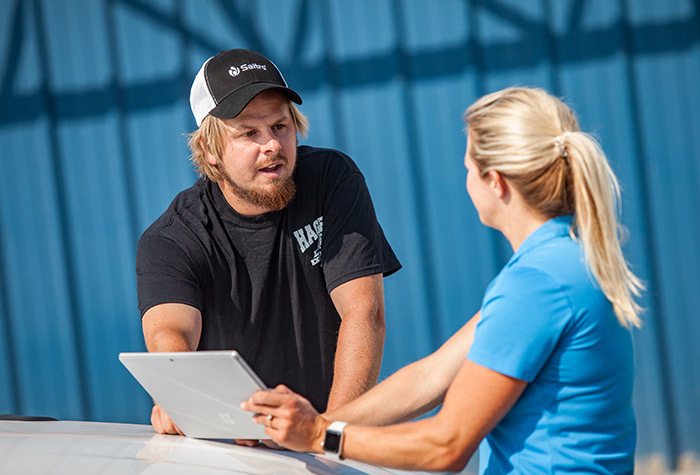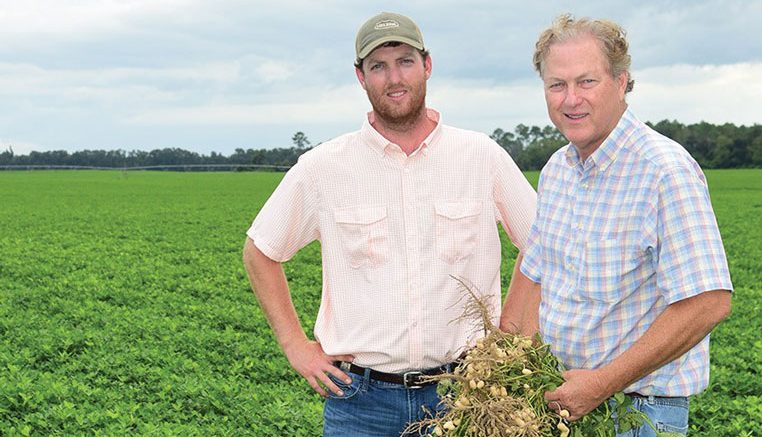Transferring farm ownership from one generation to the next can be a challenging but rewarding process.
BY JEFF JONES / PHOTOGRAPHY BY TODD STONE
Keeping a farm in the family is often a strongly felt responsibility and an essential goal that’s wholly possible to reach. For two growers whose geographies and circumstances vary greatly, generational succession was a success because of methodical planning and tempered decision-making.
Playing the Long Game
Glenn Heard has been on both sides of the farm succession equation. He gradually took over his father’s farm in Brinson, Georgia — a 16,000-acre operation where cotton, peanuts, various grains, sweet corn and carrots are grown — and now looks to pass it on to his son.
“We did it differently than most farm families,” Heard says. “I started my own farm in 1980 as a separate operation and shared equipment with my father. My operation got bigger over time after I acquired land from outside farms as well as from my father as he transitioned out of the business. By 1995, I was able to take over his farm completely.”
He kept the long path to succession orderly by hiring dependable farm managers to oversee the respective operations of father and son. Heard is now grooming his son to take over in much the same way, getting him started on his own farm and sharing equipment. Plans and fortunes may change; but with a measured, long-term process in place, they will be able to face unforeseen challenges more easily.
When Succession Is a Surprise
In sharp contrast, Kory Hagen, who runs a 1,000-acre corn farm in Cylinder, Iowa, had succession abruptly thrust upon him in his early 20s, when his father suffered a stroke. The elder Hagen had to relinquish primary management of the farm as a result. Luckily, the younger Hagen had shown a knack for farming early on and worked the fields side by side with his father from a young age.
Even in the midst of running a successful excavation and trucking businesses that he founded, Hagen hit the ground running and found ways to modernize the operation his father had started. He decided to focus on no-till farming, a decision that ultimately benefits the environment.
“We used to run a more old-fashioned farm, operating five different tractors and two older combines for beans, ripping up everything, and cultivating twice,” Hagen says. “It was a tough transition, but I decided to go the strip-till route. That eliminated the need to buy a ripper, cultivator and additional tractor. We could just lease one new tractor and use it to farm 1,000 acres.”
After a few growing pains, Hagen learned to run his father’s farm more efficiently and sustainably with a five-man team. Today, as a 28-year-old owner, he makes most of the decisions but also has a small team of advisers, including a banker who juggles marketing duties, and an accountant, whom Hagen has known since eighth grade.
“It was hard going from farming with my dad to being 100% on my own,” Hagen says. “If anything failed, it was nobody’s fault but mine, which was the biggest challenge. But I’ll always farm, no matter what. It’s very peaceful; and once it’s in your blood, it’s there for life.”
Unexpected Approaches
Some farmers approaching retirement age may not be willing to give up the reins just yet. For those who wish to continue to take an active role after relinquishing some control, there are two options that could be ideal, according to Danny Klinefelter, Ph.D., retired professor of agricultural economics at Texas A&M University.
“Collaborative farming is becoming more common,” he says. “Let’s say you excel at crop production, and another nearby farm has a better grasp on marketing. By joining forces, you can share responsibilities and focus on respective strengths. You may also get access to better equipment and increase your collective buying power.”
Farm mergers provide a similar option to collaborative farming; but instead of running things as equals, a smaller farm can be annexed into a larger operation, retaining a considerable stake in ownership in the process.
“Farms continue to grow and consolidate at a rapid pace,” Klinefelter explains. “Many smaller farms don’t have the resources to grow that fast, but owners want their kids to have a chance at a future by any means necessary. Merging with a larger operation can set the next generation up for success and give the family a continued role in running things.”
The Big Picture
For growers like Heard and Hagen, it’s a common dream to one day pass on their farms to someone in the family, keeping generational success alive for decades to come. It’s not always easy and, according to research from the University of Missouri, not as likely to succeed as turning over the business to an outside party. Only 30% of farms succeed when passed on to a family member, compared with a 70% success rate when farms are transferred to an external party.
Farmers improve their odds with careful planning that includes the next farm leaders. The parties must navigate local and state tax structures, transfer fixed capital assets and land, plot out retirement strategies, and have difficult business conversations.
Lynn Sandlin, business intelligence manager for Syngenta, urges anyone broaching the subject of farm succession to step back and think about what this complex process entails.
“A farm is more than just an enterprise — it’s a way of life,” he explains. “Elder farmers think of it not just as a business with land and equipment, but also as a legacy they’re leaving behind for children, grandchildren and so on.”
When considering all this, it’s no wonder that passing a farm into the hands of family members is such a difficult task. But with the right mindset and strategy, the promise of generational farm succession — whether complete or partial — is possible.
SOURCE: Syngenta Thrive Fall 2020


